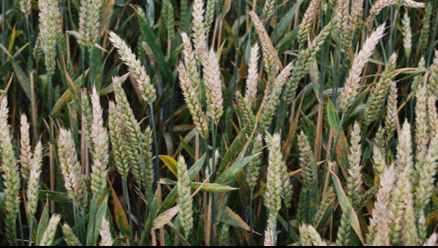Exploring how a hazardous fungal pathogen ‘tastes’ its surroundings within a wheat plant to coordinate virulence could be the key to developing new control strategies, scientists believe.
Researchers at the University of Bath and Rothamsted Research have been examining how “fungal G-protein coupled receptors”, which are similar to taste receptors on our tongues, are involved in promoting Fusarium Head Blight (FHB) – a damaging and hazardous disease of wheat which is the number one floral disease in cereals globally.
Fusarium Head Blight targets the ear and grain of the wheat plants and is therefore a major problem for farmers of one of the world’s most important crops. The disease is economically costly, damaging wheat crops towards the end of the growing cycle, and contaminating the wheat grain with fungal toxins (mycotoxins) which are dangerous for humans and animals to eat.
In the UK we have outbreaks of FHB every few years, experiencing wheat crop losses of around 10% in 2012. In other parts of the world such as the USA, Brazil and China, the disease causes severe crop losses and mycotoxin contamination problems for farmers every harvest.
Currently there are no truly effective ways to control FHB, which is spread by airborne spores.
The research team, led by fungal biologist Dr Neil Brown from the University of Bath’s Department of Biology & Biochemistry, thinks that G-protein coupled receptors are a promising targets to develop new approaches to control fungal diseases, including the FHB causing pathogen Fusarium graminearum.
These fungal receptors ‘taste’ their environment and signal changes to the fungi cell, kicking off an appropriate biological response, including mating, mycotoxin production and virulence.
In a series of experiments the scientific team demonstrated that F. graminearum’s receptors are important in wheat infection. The team made a collection of fungal mutants lacking individual receptors. They went on to show that the absence of one type of receptor, specific to fungi, allowed the wheat plant to mount a stronger defence, which causes a traffic jam of invading filamentous fungal structures called hyphae and reducing the progression of infection.
The team also showed that the removal of this receptor meant that the virulence on wheat was reduced, because various fungal processes required for infection were disrupted and dysregulated.
The research is published in PLOS Pathogens.
Dr Brown said: “Fusarium Head Blight is the number one floral disease of cereals worldwide.
“G-protein coupled receptors have been studied extensively in humans, where around 40% of our pharmaceuticals target these human receptors, as they’re exposed on the cell surface, making them accessible to drugs, and they control important biological functions. Fungi have their own G-protein coupled receptors, but we know very little about them.
“Our results show that fungal receptors are important for Fusarium infection of wheat. By learning more about the structure and function of these fungal-specific receptors, and the compounds they detect, we may be able to develop new approaches to control FHB and other plant pathogens.”
Professor Kim Hammond-Kosack, from Rothamsted Research, said: “The options to control Fusarium floral infections in cereal crops are very limited at the moment. This is causing growers and processors in the food and feed industries a tremendous headache, and why Rothamsted has been looking to apply our considerable expertise in crop diseases to this problem. These results open up the possibility of devising novel ways to control FHB disease through either targeted drug development or by eliminating the signals these receptors perceive during a fungal attack.”
The research was funded by the Biotechnology and Biological Sciences Research Council through its Future Leaders Fellowship Programme awarded to Dr Neil Brown.
“Non-canonical fungal G-protein coupled receptors promote Fusarium head blight on wheat” is published in PLOS Pathogens and is available as an open access paper.

